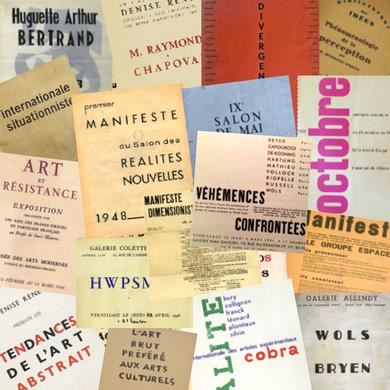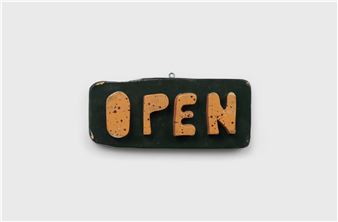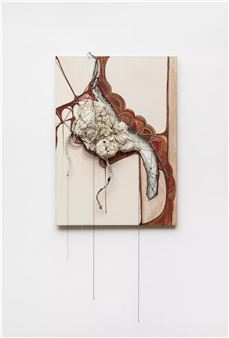Fourth Republic 1946-1958
In 1946 with the resignation of de Gaulle and two referendums, the Fourth Republic marked a twelve year period of political turmoil with 18 different prime-ministers as France struggled to rediscover its identity. Dissatisfied with the state of affairs in 1947 the RPF (Rassemblement du Peuple Francais) began organising a series of national strikes, and in 1948 the situation resulted in bread rationing and the devaluation of the Franc.
A consequence of the ongoing instability was fervent creativity, as artists felt impelled to explore new ways of thinking and seeing, a new outlook. In 1946 Merleau-Ponty had just published his вҖңPhenomenology of PerceptionвҖқ, and Sartre вҖңLes Temps ModernesвҖқ; Le Corbusier designed the вҖңCitГ© RadieuseвҖқ in Marseille; and the avant-garde вҖңSalon des RГ©alitГ©s NouvellesвҖқ was launched; while the communist painter AndrГ© Fougeron won the Prix National des Arts; in 1947 Dior launched the вҖңNew LookвҖқ; the MusГ©e National dвҖҷArt Moderne opened with вҖңArt et RГ©sistanceвҖқ; and Galerie Maeght held the вҖңExposition Internationale du SurrealismeвҖқ organised by Breton and Duchamp. It was the era of Camus, de Beauvoir, Beckett and Ionesco. Art movements such as Tachisme, Art Brut, CoBrA, Espace, Abstraction LyriqueвҖҰ
This exhibition at Hanina Fine Arts charts these developments through a selection of representative works from this extraordinary era. Including Camille BryenвҖҷs important Tachiste work вҖңFomalhautвҖқ exhibited at the Stedelijk Museum in 1957; and Abstraction Lyrique works by Jean Le Moal and James Pichette; CoBrA artist Georges CollignonвҖҷs вҖңVives ControversesвҖқ exhibited in the international CoBrA exhibition in 1951; geometric abstract works by вҖңEspaceвҖқ group founders Silvano Bozzolini and Emile Gilioli; avant-garde think-tank вҖңCentre de RechercheвҖқ organiser Jean Deyrolle; prominent women artists Marie Raymond and Huguette Bertrand; and Г©migrГ©s Pierre Dmitrienko and Youla Chapoval.

Recommended for you
In 1946 with the resignation of de Gaulle and two referendums, the Fourth Republic marked a twelve year period of political turmoil with 18 different prime-ministers as France struggled to rediscover its identity. Dissatisfied with the state of affairs in 1947 the RPF (Rassemblement du Peuple Francais) began organising a series of national strikes, and in 1948 the situation resulted in bread rationing and the devaluation of the Franc.
A consequence of the ongoing instability was fervent creativity, as artists felt impelled to explore new ways of thinking and seeing, a new outlook. In 1946 Merleau-Ponty had just published his вҖңPhenomenology of PerceptionвҖқ, and Sartre вҖңLes Temps ModernesвҖқ; Le Corbusier designed the вҖңCitГ© RadieuseвҖқ in Marseille; and the avant-garde вҖңSalon des RГ©alitГ©s NouvellesвҖқ was launched; while the communist painter AndrГ© Fougeron won the Prix National des Arts; in 1947 Dior launched the вҖңNew LookвҖқ; the MusГ©e National dвҖҷArt Moderne opened with вҖңArt et RГ©sistanceвҖқ; and Galerie Maeght held the вҖңExposition Internationale du SurrealismeвҖқ organised by Breton and Duchamp. It was the era of Camus, de Beauvoir, Beckett and Ionesco. Art movements such as Tachisme, Art Brut, CoBrA, Espace, Abstraction LyriqueвҖҰ
This exhibition at Hanina Fine Arts charts these developments through a selection of representative works from this extraordinary era. Including Camille BryenвҖҷs important Tachiste work вҖңFomalhautвҖқ exhibited at the Stedelijk Museum in 1957; and Abstraction Lyrique works by Jean Le Moal and James Pichette; CoBrA artist Georges CollignonвҖҷs вҖңVives ControversesвҖқ exhibited in the international CoBrA exhibition in 1951; geometric abstract works by вҖңEspaceвҖқ group founders Silvano Bozzolini and Emile Gilioli; avant-garde think-tank вҖңCentre de RechercheвҖқ organiser Jean Deyrolle; prominent women artists Marie Raymond and Huguette Bertrand; and Г©migrГ©s Pierre Dmitrienko and Youla Chapoval.

 ARTISTS
ARTISTS
















